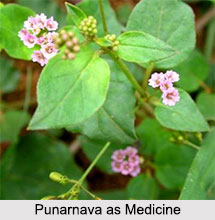 Boerhavia diffusa commonly called Punarnava is one of the very important anti inflammatory medicinal herbs. Both the red and white varieties of this plant are noticed by Sanskrit writers but the white is preferred for use.
Boerhavia diffusa commonly called Punarnava is one of the very important anti inflammatory medicinal herbs. Both the red and white varieties of this plant are noticed by Sanskrit writers but the white is preferred for use.
Health Benefits of Punarnava
Its root is regarded as laxative, diuretic and stomachic; it is used in jaundice, ascites, anasarca, scanty urine and internal inflammations. One of its Sanskrit synonyms, namely, sothagni means cure for dropsy. It is well known for its diuretic and swelling reducing activities.
Dose of Punarnava in Medicine
A decoction of Punarnava root is recommended to be given with the addition of powdered chireta and ginger in anasarca. A compound decoction much used in this disease is prepared as follows.
Punarnavashaka: Take Punarnava root, neem bark, leaves of Trichosanthes dioica (patola), ginger, Picrorrhiza Kurroa (katuki), chebulic myrobalan, gulancha, and the wood of Berberis Asiatica (daruharidra), quarter of a tola each, water 32 tolas; boil together till reduced to one-fourth. This decoction is given in general anasarca with ascites, cough, jaundice, difficult breathing, etc.
An oil, prepared with a decoction of the root and a number of the usual aromatics in the form of a paste, is rubbed on the body in general anasarca complicated with jaundice. It is called Punamava Taila.
The Bhavaprakasa gives an electuary under the name of Punarnavavaleha. It is prepared with a decoction of the root of Boerhaavia diffusa and a number of other ingredients and is used in strangury or scanty urine.
This article is a stub. You can enrich by adding more information to it. Send your Write Up to content@indianetzone.com
Related Articles
Ayurveda
Origin of Ayurveda
Ayurveda Medication
Elements of Ayurveda
Concepts of Ayurveda
Ancient Literature of Ayurveda
Sushruta Samhita





